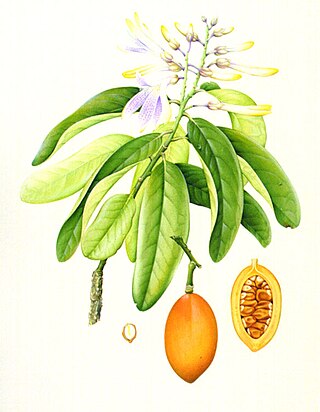Top Qs
Timeline
Chat
Perspective
Xanthophyllum fragrans
Species of flowering plant From Wikipedia, the free encyclopedia
Remove ads
Xanthophyllum fragrans, commonly known as fragrant boxwood, is an evergreen plant in the family Polygalaceae found only in the Wet Tropics bioregion of Queensland, Australia.
Remove ads
Description
Summarize
Perspective
Xanthophyllum fragrans is a tree growing up to about 20 m (66 ft) tall, and it may produce buttress roots. The leaves are simple, arranged alternately and attached to the twigs by petioles about 10 mm (0.39 in) long; they are glossy dark green above and paler green below, and measure up to 20 cm (7.9 in) long by 7 cm (2.8 in) wide.[4][5][6]
The inflorescences are produced either terminally or in the leaf axils, and they take the form of a raceme about 12 cm (4.7 in) long. The flowers are very fragrant and quite large with five cream to yellow petals up to 7 cm (2.8 in) long and 1 cm (0.39 in) wide. The stamens are about 55 mm (2.2 in) long with anthers about 3 mm (0.12 in) long; the style is about 40 mm (1.6 in) long, the stigma is capitate (i.e. like the head of a pin).[4][5][6]
The orange fruit is (in botanical terms) a berry measuring about 9 cm (3.5 in) long and 4.5 cm (1.8 in) wide. They contain 8 or more seeds measuring about 15 mm (0.59 in) by 12 mm (0.47 in), which are completely enclosed in a cream aril.[4][5][6]
Phenology
Flowering occurs from September to October, and fruit ripen in December and January.[6]
Remove ads
Taxonomy
This species was first described by the Australian botanist Cyril Tenison White in his paper titled Contributions to the Queensland Flora, No. 6, which was read to the Royal Society of Queensland in November 1938. It was subsequently published in the Society's journal Proceedings of the Royal Society of Queensland in 1939.[7]
Distribution and habitat
Xanthophyllum fragrans has a restricted distribution within Queensland's Wet Tropics World Heritage Area, from near Cape Tribulation to the Kuranda National Park. It grows in well developed rainforest at altitudes from near sea level up to 1,000 m (3,300 ft).[4][5][6][8]
It has a total Area of Occupancy[a] of just 120 km2 (46 sq mi).[9]
Conservation
This species is listed by the Queensland Government's Department of Environment, Science and Innovation as near threatened.[1] As of 15 April 2024[update], it has not been assessed by the International Union for Conservation of Nature (IUCN).
Cultivation
This species is too large for the average suburban garden but it has potential as an attractive park tree due to its large fragrant flowers and colourful fruit.[5]
Gallery
- Foliage and habit
- Flower buds
- Flowering
- Mature fruit
- Leaf x-ray
References
Notes
External links
Wikiwand - on
Seamless Wikipedia browsing. On steroids.
Remove ads






